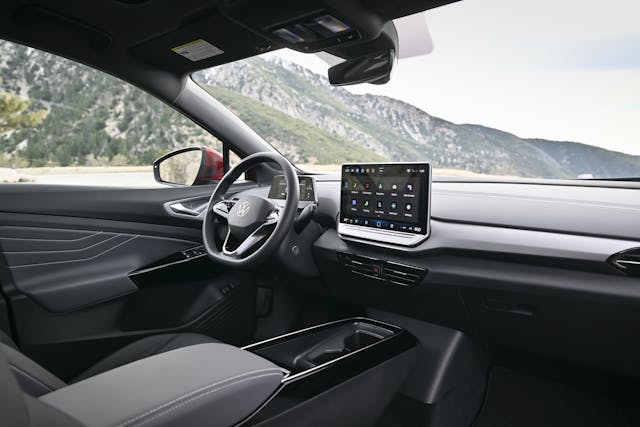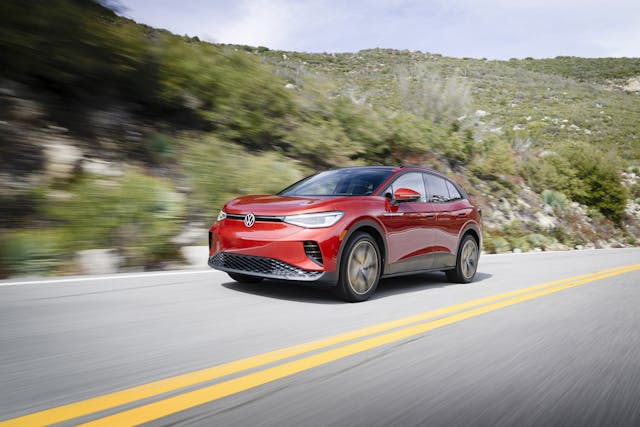2024 VW ID.4 Review: Most Improved
Last year was a pretty good one for the VW ID.4 in America. The compact EV crossover comprised 11.5 percent of VW’s total sales in 2023, and the majority of those buyers were new to the brand. (Conquest sales are a big deal.) VW is hoping to keep that momentum going by making constant updates to the ID.4, including some major ones for 2024. We’ve had a few opportunities to test this all-electric compact crossover since its launch for the 2021 model year, each of which we walked away from with a sense that there was, indeed, room for improvement.
We spent a morning driving around Los Angeles suburbs, highways, and mountain roads in the 2024 ID.4 to get a feel for some of the changes VW made. Our most serious complaints were: lack of driver engagement, unsettling brake and suspension tuning, and a maddening user interface for the center touchscreen.

For starters, this year’s ID.4 has more power than before. The rear-drive Standard and S models use a 62-kWh battery and single electric motor that deliver 201 hp, 229 lb-ft of torque, and 206 miles of estimated range (down from 209 miles in 2023). We drove a Pro S trim that uses a single electric motor to power the rear wheels, albeit with a larger 82-kWh battery that carries an EPA-estimated 291-mile range (up from 275 miles in 2023). Power in the RWD Pro models is now up to 282 hp and 402 lb-ft of torque thanks to a new motor that packs more copper windings and features a more power-dense package. Along with the extra power comes improved cooling and efficiency. The added power drops its 0-60 mph time from an adequate 7.7 seconds to a brisk 5.9 seconds. For those looking for more gusto, all-wheel-drive trims, which exclusively use the 82-kWh battery, now offer 335 hp and a 263-mile range rating (up from 255 miles in 2023).
The Standard trim has a starting price and destination of $41,162, while Pro models with the ID.4’s best range start at $45,290. AWD models begin at $49,090. Because the ID.4’s battery cells are domestic in origin and assembled at VW’s Chattanooga, Tennessee plant, all 2024 examples are eligible for the $7,500 federal tax credit.

Specs: 2024 Volkswagen ID.4 Pro S
- Price: $51,420 / $51,815 (base / as-tested)
- Powertrain: 82-kWh lithium-ion battery, rear electric motor, single-speed transmission
- Horsepower: 282 hp
- Torque: 402 lb-ft
- Layout: Four-door, five-passenger, rear-wheel-drive unibody SUV
- EPA-rated MPGe: 122 city, 104 highway, 113 overall
- 0-60 mph: 5.9 seconds
- Competitors: Hyundai IONIQ 5, Kia EV6, Ford Mustang Mach-E, Tesla Model Y, upcoming Chevy Equinox EV
Benefiting from the low center of gravity typical of modern EVs and the immediate torque from the rear drive unit, the ID.4 was surprisingly competent and fun on canyon roads. At a minimum, it does a nice job of hiding its roughly 4600-pound curb weight. While we didn’t push the car to its absolute limits, the ID.4 didn’t react to forceful acceleration or braking with the unsettled body motions that we described experiencing in earlier models. VW says it didn’t tweak the suspension for 2024, but that the regen is “slightly higher” and that the pedal mapping is “a bit more direct in the drive modes.”

Shifting from standard drive mode to “B” increases the force of regenerative braking. The difference is noticeable but not abrupt—lifting off the throttle doesn’t press one forward into the seatbelts. On our downhill drive through the canyons and back to the highway, we witnessed the regenerative braking gauge in the dash cluster reach nearly three-quarters of its total capacity without pressure on the brake pedal. Even at full regen strength, however, the ID.4 is not capable of one-pedal driving. In order to reach a complete stop, the driver must apply braking force via the pedal.
Whether in the canyons or on urban streets, the throttle response and regen braking felt well-tuned and did not surprise or throw us for a loop in any way. Compared with past ID.4s, a driver new to EVs would have no problem getting used to the ID.4.

Despite its compact footprint, the ID.4’s interior offers more than adequate space for tall drivers thanks to a slim center console that retains plenty of legroom. Our only complaint on ergonomics is the placement of the forward section of the door armrest that houses the mirror adjustment. It’s right where the driver’s left knee tends to be when their foot is on the dead pedal. It doesn’t have a stitch of padding. Other than that, the packaging is efficient and the shallow-bolstered seats are very comfortable, with a satisfying give to the foam.

Just like previous ID.4 models, the binnacle for Volkswagen’s ID.Cockpit digital display appears to sit on top of the steering column rather than integrated with the dashboard. It is not the most elegant design choice, but it efficiently delivers all the necessary information. As for the interior materials, there is quite a bit of piano black and not many physical buttons. The buttons that do remain (operating the headlights, fog lights, and front/rear defrosters) are on a rather flat, rubber-covered panel on the dash by the driver’s left knee. It seems appropriate for a UTV or boat and strangely out of place in the ID.4.


VW seems to have heeded critics of the previous ID.4’s user interface. Compared to when it launched in the United States, the 2024 model boasts a larger infotainment screen, now measuring 12.9 inches diagonally, combined with improved software that better recognizes voice commands. The bottom edge of the 12.9-inch screen is now devoted to permanently displaying HVAC controls, which now illuminate in dark conditions. That remedied some of the most vocal complaints leveled against the previous iterations of the ID.4. Those often-used controls were previously layered one menu deep in the software interface.
While there still aren’t any dedicated physical buttons for the center stack (apart from the hazards) it’s a lot better than the interface in the ID.4’s very distant Volkswagen Group cousin, the Lamborghini Huracan Sterrato. At least on the ID.4, some of the most-used functions get steering wheel controls. But then, a hum-drum electric family car should be a bit more approachable than a 600-hp mid-engine pseudo-rally car, right?
As VW plans to roll out more EVs, ranging from the Microbus-successor ID.Buzz and the mid-size ID.7 electric sedan, the ID.4 will remain a major player in the brand’s future strategy. Continual improvement in response to customer and critical feedback is never a bad thing. The ID.4 offers decent range for the money, though its topline figures still lag behind the Ioniq 5 (303 miles), EV6 (310 miles), Model Y (310 miles) and Mustang Mach-E (312 miles). On the plus side, the ID.4 benefits from considerably better packaging than its rivals, resulting in more usable passenger and cargo space. As an everyday EV, if that type of car works for your lifestyle, the ID.4 deserves to be in the conversation.
2024 Volkswagen ID.4 Pro S
Highs: Competitive pricing; domestic production/battery sourcing make it eligible for tax rebates. Roomy interior with comfortable seating. Practical improvements to infotainment, as well as improved power and efficiency.
Lows: Interior is a bit drab, and the infotainment is still far from top-of-class. Still no one-pedal driving mode.
Takeaway: The Volkswagen ID.4 is a solid compact EV SUV, particularly for the price- and cargo capacity-conscious. Improvements noted.
***
Check out the Hagerty Media homepage so you don’t miss a single story, or better yet, bookmark it. To get our best stories delivered right to your inbox, subscribe to our newsletters.







Does it have a heat pump for HVAC? If not, range will suffer badly in places with real winters.
I still don’t understand why heat pumps are not in all EVs, is it really THAT hard to run an air conditioner backwards to move heat?
Andrew, it probably just comes down to cost. Sometimes buyers are too cheap for their own good and wouldn’t pay more for the better system. Or there are those that wouldn’t need it and the even greater cost of supplying two versions can’t be justified. These EVs are probably not money-makers as it is, so anything that adds cost is surely examined with more than one watchful eye.
That interior is still boring. It looks like two tiny ipads mounted on the dash. It looks generic VW on the outside which is fine for the average consumer.